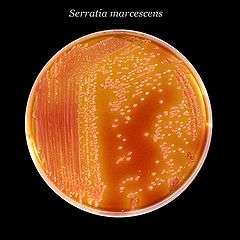Serratia
| Serratia | |
|---|---|
 | |
| Serratia marcescens, a typical species, on XLD agar.[1] | |
| Scientific classification | |
| Domain: | Bacteria |
| Phylum: | Proteobacteria |
| Class: | Gammaproteobacteria |
| Order: | Enterobacteriales |
| Family: | Enterobacteriaceae |
| Genus: | Serratia |
| Species | |
|
S. aquatilis[4] | |
Serratia is a genus of Gram-negative, facultatively anaerobic, rod-shaped bacteria of the Enterobacteriaceae family. The most common and pathogenic of the species in the genus, S. marcescens, is normally the only pathogen and usually causes nosocomial infections. However, rare strains of S. plymuthica, S. liquefaciens, S. rubidaea, and S. odoriferae have caused diseases through infection.[5] S. marcescens is typically found in showers, toilet bowls, and around wetted tiles. Members of this genus produce characteristic red pigment, prodigiosin, and can be distinguished from other members of the Enterobacteriaceae family by their unique production of three enzymes: DNase, lipase, and gelatinase.[6]
Infection of humans
The bacterium is an opportunistic human pathogen, capitalizing on its ability to form tight-knit surface communities called biofilms wherever it can.[7] S. marcescens is thought to be transmitted through hand-to-hand transmission by hospital personnel.[7] In the hospital, Serratia species tend to colonize the respiratory and urinary tracts, rather than the gastrointestinal tract, in adults. Serratia infection is responsible for about 2% of nosocomial infections of the bloodstream, lower respiratory tract, urinary tract, surgical wounds, and skin and soft tissues in adult patients. Outbreaks of S. marcescens meningitis, wound infections, and arthritis have occurred in pediatric wards.[8]
Cases of Serratia arthritis have been reported in outpatients receiving intra-articular injections.
Isolation and identification
Several methods can be used to study the epidemiology of S. marcescens. Serological typing and different types of polymerase chain reaction can be used to identify the bacteria. Biotyping, bacteriocin typing, phage typing, plasmid analysis, and ribotyping can also be used[9] S. marcescens appears red on trypticase soy agar slants when grown at around 25°C.[10] S. marcescens and S. liquefaciens can be easily confused in the lab when using the analytical profile index system. They can both oxidise arabinose, but only S. liquefaciens can ferment arabinose in peptone water.[9]
History
S. marcescens was first documented as a red-coloured putrefaction of polenta[11] by Bartolomeo Bizio in Padua. The bacterium was later named in honour of Italian physicist Serafino Serrati and marcescens because of the pigment's rapid discolouration and decay.[11]:538
References
- ↑ Images courtesy of CDC Accessed 7 July 2011.
- ↑ BIZIO (B.): Lettera di Bartolomeo Bizio al chiarissimo canonico Angelo Bellani sopra il fenomeno della polenta porporina. Biblioteca Italiana o sia Giornale di Letteratura, Scienze e Arti (Anno VIII), 1823, 30, 275-295. link.
- ↑ "Serratia". In: List of Prokaryotic Names with Standing in Nomenclature (LPSN). Created by J.P. Euzéby in 1997. Curated by A.C. Parte since 2013. Available on: http://www.bacterio.net. Retrieved 7 July 2017.
- 1 2 3 4 5 LPSN bacterio.net
- ↑ Basilio J. Anía, M.D. "Serratia". eMedicine. Retrieved 2007-03-14.
- ↑ "Serratia". University of Texas at Houston Medical School. Archived from the original on 2007-01-28. Retrieved 2007-03-14.
- 1 2 Basilio J Anía (21 October 2015). "Serratia". Medscape.
- ↑ Health Canada. MSDS - Infectious Substances. Serratia. (http://www.phac-aspc.gc.ca/lab-bio/res/psds-ftss/msds138e-eng.php) Accessed 7 July 2011.
- 1 2 Hejazi, A; Falkiner, F (November 1997). "Serratia marcescens". J. Med. Microbiol. 46 (11): 903–912. doi:10.1099/00222615-46-11-903. PMID 9368530.
- ↑ .Leboffe, Michael J., and Burton E. Pierce. "Section 3: Bacterial Growth." A Photographic Atlas for the Microbiology Laboratory. 4th ed. Englewood, CO: Morton Pub., 2011. 26. Print.
- 1 2 Merlino, CP (November 1924). "Bartolomeo Bizio's Letter to the most Eminent Priest, Angelo Bellani, Concerning the Phenomenon of the Red Colored Polenta". Journal of Bacteriology. 9: 527–543. PMC 379088. PMID 16559067.